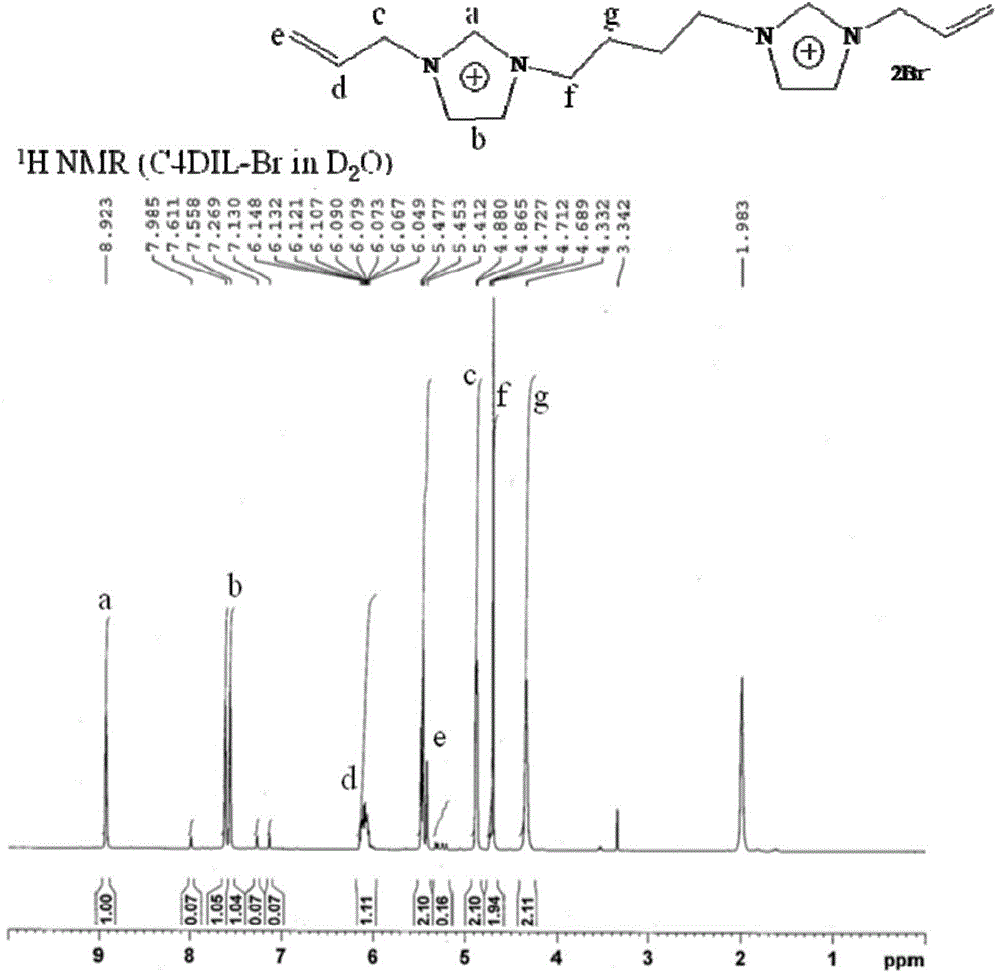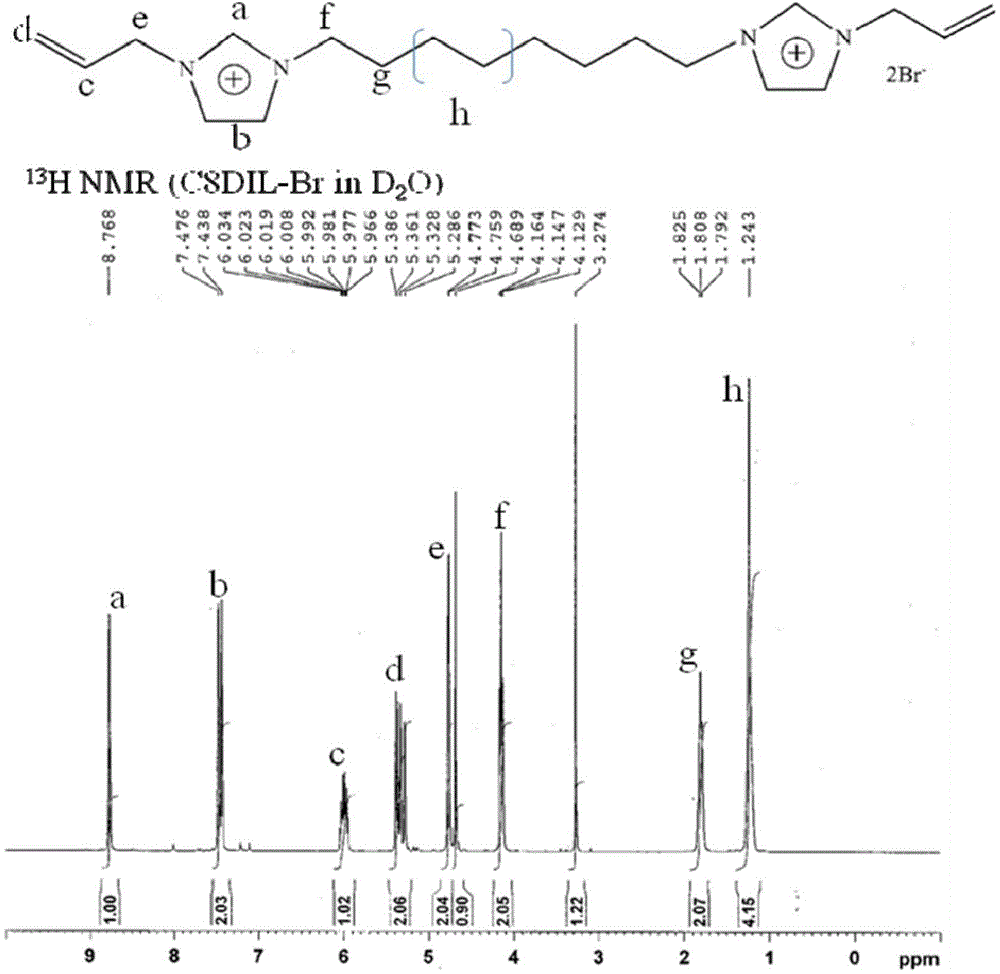Am imidazole dicationic ionic liquid hydrophilic interaction chromatography stationary phase, and preparation and applications thereof
A chromatographic stationary phase and double cation technology, applied in the field of high performance liquid chromatography stationary phase
- Summary
- Abstract
- Description
- Claims
- Application Information
AI Technical Summary
Problems solved by technology
Method used
Image
Examples
Embodiment 1
[0027] Example 1: Preparation of Dicationic Liquid
[0028] Dissolve 1-allylimidazole and 1,4-dibromobutane in methanol solvent at a molar ratio of 3.5:1, stir and heat to 65°C under argon protection for about five days under reflux reaction, after cooling, vacuum rotary evaporation removes Methanol, the remaining mixture was washed five times with ethyl acetate to remove unreacted raw materials to obtain a light yellow viscous liquid, that is, a dicationic liquid 1,4-bis(3-allylimidazole)butane dibromide (C4DIL-Br ), dried under vacuum at 60°C. Then, 1,4-bis(3-allylimidazole) butane bis(bis-trifluoromethylsulfonimide) salt (C4DIL-NTf 2 ), the steps are as follows: 3.5g C4DIL-Br is dissolved in water, and the bis-trifluoromethylsulfonylimide lithium salt (LiNTf 2 ) solution, after adding dichloromethane with the same volume as water, stir at 35°C for 40 hours, and remove the upper water layer after standing for stratification, and continue to wash the dichloromethane layer w...
Embodiment 2
[0031] Example 2: Preparation of Dicationic Liquid Bonded Silica Gel Stationary Phase
[0032] Silica balls (particle size 3μm, specific surface area 310m 2 g -1 ) at 100°C for 24 hours in vacuum, after cooling, disperse in anhydrous toluene and stir evenly. Reflux at 110°C for 24 hours, centrifuge, wash with methanol five times to obtain silica spheres with 3-mercaptopropyl groups bonded to the surface, and dry at 60°C in vacuum.
[0033] Through the click chemical reaction of thiol and double bond, the prepared dianionic liquid C4DIL-Br, C4DIL-NTf 2 and C8DIL-NTf 2 Bonded to the surface of silica spheres with 3-mercaptopropyl groups bonded to the surface. Disperse the silicon spheres with 3-mercaptopropyl groups bonded on the surface in methanol, add the cation liquid (the molar number of double bond groups is 2-3 times that of the mercapto groups on the surface of the silicon spheres) and 1%-2% mass ratio of the two The initiator AIBN was reacted at reflux at 60°C for ...
Embodiment 3
[0036] Example 3: Evaluation of Dicationic Liquid Bonded Silica Gel Stationary Phase
[0037] First, the elemental analysis was carried out on the ionic liquid bonded silica gel stationary phase, and Table 1 lists the elemental characterization results. At the same time, the column efficiency of the dicationic liquid-bonded silica gel stationary phase is listed, the column efficiency uses cytosine as the probe, and the mobile phase is 95% ACN (10mM NH 4 FA) / H 2 O (10mM NH 4 FA)=95 / 5(v / v), isocratic elution, DAD254nm detection, flow rate 0.2mL / min.
[0038] Table 1 Properties of ionic liquid bonded silica gel stationary phase
[0039]
[0040] Secondly, nucleoside mixtures, nucleic acid base mixtures and substituted benzoic acid mixtures were used to evaluate the retention behavior and selectivity of dianionic liquid-bonded silica stationary phases under hydrophilic interaction chromatography conditions. Figure 4 and Figure 5 The separation chromatograms of the nucleo...
PUM
| Property | Measurement | Unit |
|---|---|---|
| particle diameter | aaaaa | aaaaa |
Abstract
Description
Claims
Application Information
 Login to View More
Login to View More - R&D
- Intellectual Property
- Life Sciences
- Materials
- Tech Scout
- Unparalleled Data Quality
- Higher Quality Content
- 60% Fewer Hallucinations
Browse by: Latest US Patents, China's latest patents, Technical Efficacy Thesaurus, Application Domain, Technology Topic, Popular Technical Reports.
© 2025 PatSnap. All rights reserved.Legal|Privacy policy|Modern Slavery Act Transparency Statement|Sitemap|About US| Contact US: help@patsnap.com



